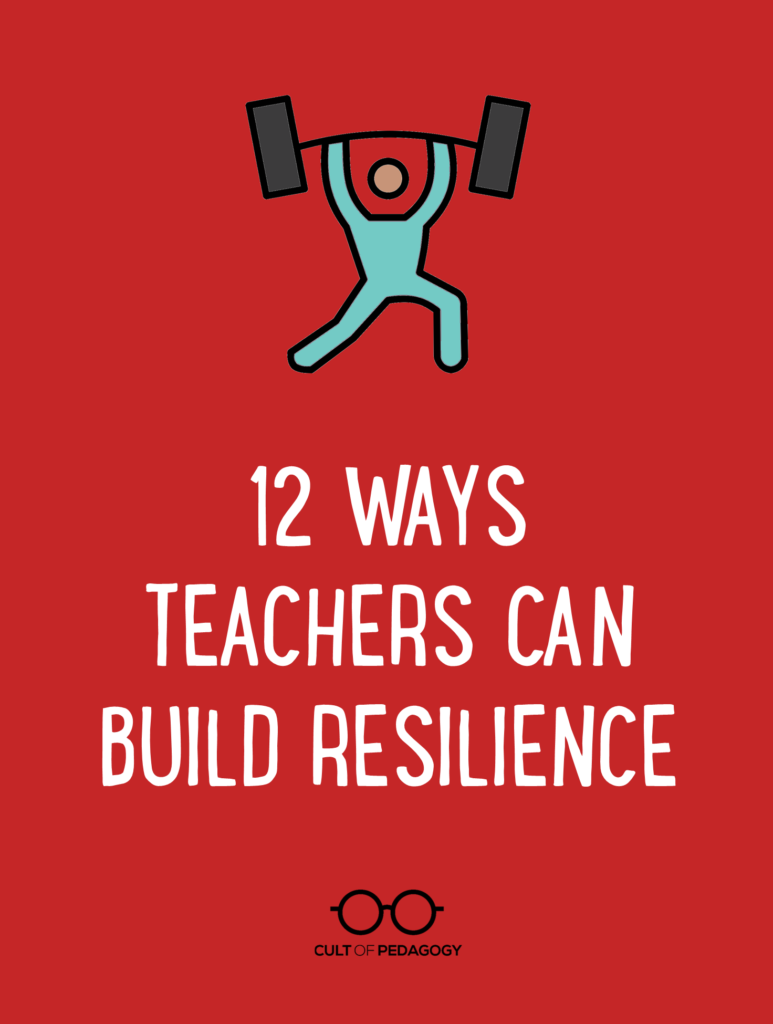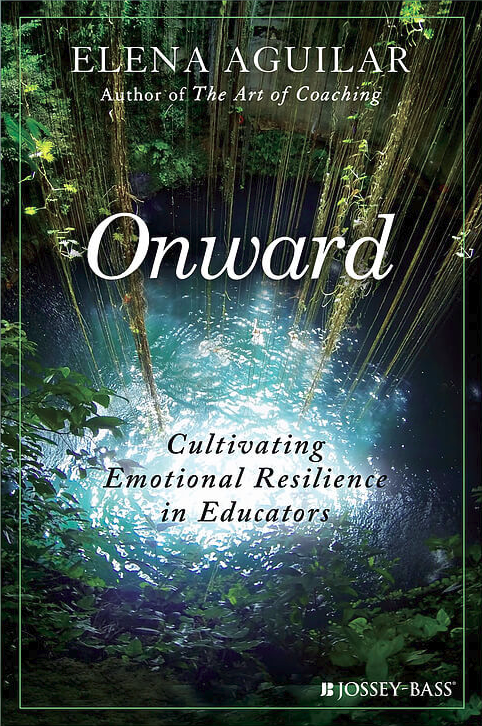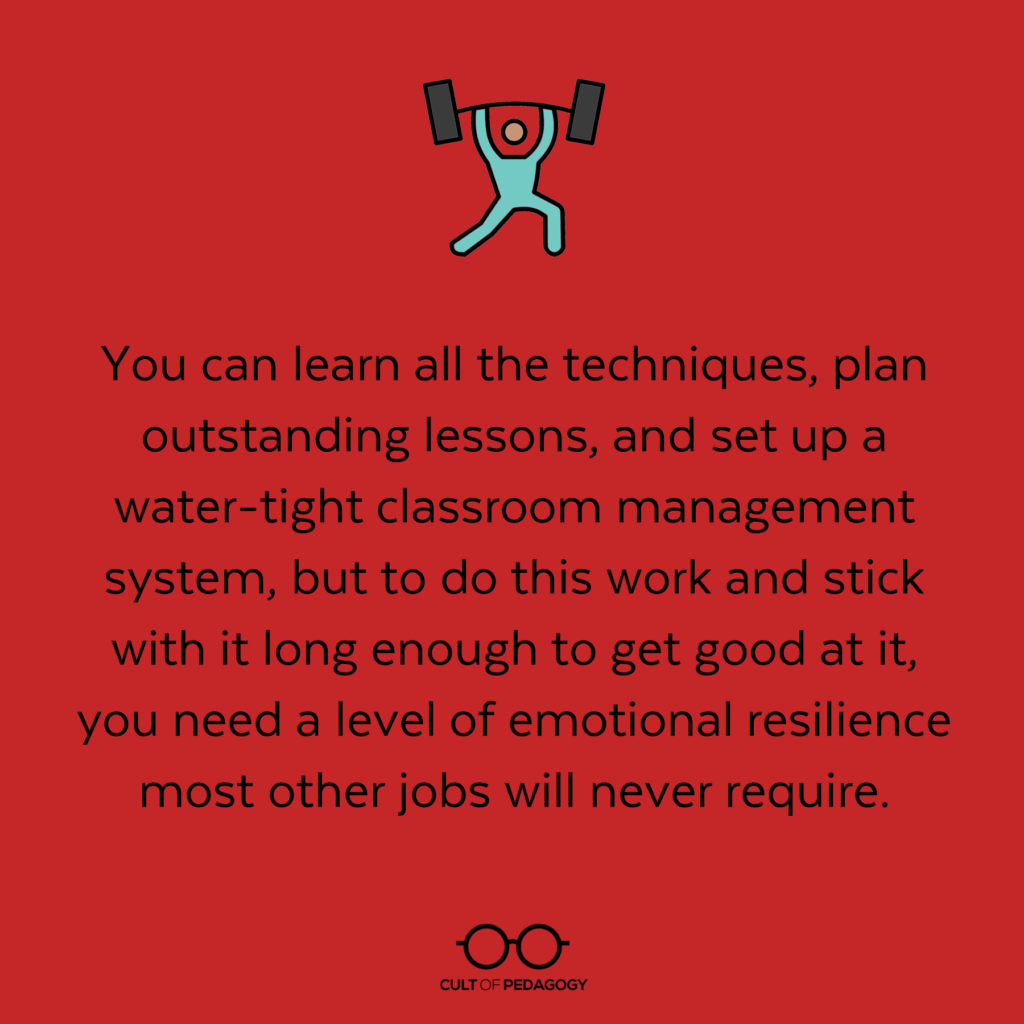
Listen to my interview with Elena Aguilar (transcript):
Sponsored by simpleshow videomaker and Screencast-O-Matic
This post contains Amazon Affiliate links. When you make a purchase through these links, Cult of Pedagogy gets a small percentage of the sale at no extra cost to you.
When talking about a profession that loses 50 percent of its workforce in the first five years of their careers, it would be an understatement to say teaching is challenging. It traps us in small rooms with an unpredictable assortment of personalities, energies, and needs. It forces us to make hundreds of small, exhausting decisions every day. And over and over again, it puts us in predicaments that test our confidence, wear out our patience, and break our hearts. You can learn all the techniques, plan outstanding lessons, and set up a water-tight classroom management system, but to do this work and stick with it long enough to get good at it, you need a level of emotional resilience most other jobs will never require.
And at this particular moment in history, teaching may be harder than ever. Systems have been put in place that make the work seem almost impossible, and the powers that be seem to be rooting against our success. A lot can be done to change that, to make the challenges of teaching more satisfying and less…soul-sucking, but on most days it can seem like those changes are pretty far outside of our sphere of influence. Finding the courage and energy to push for change despite how hard it is? That requires resilience, too.
And our teacher training never prepares us, never teaches us exactly how to develop that resilience. In fact, in my own training, the topic of my emotional state as a teacher never came up once.
The good news is that we now have a resource that focuses entirely on the topic of teacher resilience. In her book, Onward: Cultivating Emotional Resilience in Teachers, instructional coach Elena Aguilar walks us through twelve habits that teachers can develop to strengthen their emotional resilience. The book and its companion workbook are organized around a year-long calendar; Aguilar recommends that teachers work through the book slowly.
“The workbook has over 365 exercises, many of which you’ll probably want to repeat more than once,” she says. “Ideally people will be engaging in this learning with friends and colleagues so that they can have the kinds of conversations that will make this learning really sink in and stick.”

Onward: Cultivating Emotional Resilience in Educators
by Elena Aguilar
Let’s take a peek at the 12 habits now. My hope is that in getting a better understanding of the factors that contribute to emotional resilience, you’ll see areas that you can improve for yourself, and this in turn will allow you to not only stick with this incredibly important work, but find new ways to effect change, inspire others, and thrive.
12 Habits that Build Resilience
In the book, Aguilar explains how developing each of these habits contributes to resilience. She recommends focusing on a different habit each month, taking the whole month to learn about, reflect on, and develop practices that strengthen that habit. Below each habit is the month Aguilar suggests as an ideal time to focus on it: This is based on a typical American school calendar, where the school year starts around August/September and ends around May/June. If your calendar is different, you may want to make adjustments accordingly.
1. Know Yourself
Suggested month: June
Taking the time to reflect on and get clear about your values, your preferences, your skills and aptitudes, and your sociopolitical identity can help you develop a strong sense of purpose. This makes you more likely to respond to difficult situations in ways that are consistent with that purpose. “Being really anchored in your purpose,” Aguilar explains, “being really clear about what you want to be doing in life, helps you deal with challenges and setbacks.”
2. Understand Emotions
Suggested month: July
Emotions “can be tremendous resources and sources of energy,” Aguilar says. They key is figuring out “how to have healthier relationships with them, how to understand them, name them, accept them, and then work with them.” During this month, Aguilar has teachers examine the way emotions influence our thinking (and vice-versa) and how to work with them, instead of against them.
She’s especially interested in how we deal with anger. “There have been times when I’ve acted from anger, and it hasn’t been productive,” she says. “And there are other times when I figured out how to use my anger as a fuel and as energy, how to act from a place of kindness and compassion, but not suppress my anger.”
3. Tell Empowering Stories
Suggested month: August
“The space where we can have the greatest impact on our resilience is between a thing that happens and how we interpret and make sense of that thing,” Aguilar says. That interpretation takes the form of a story we tell ourselves.
“So for example, a student rolls her eyes at you. That’s the thing that happens,” she says. “How you make sense of and interpret that event is precisely the point where either your resilience can be drained or filled, because you could interpret her eye rolling as This student doesn’t respect me, or you can interpret that event as, This is very typical behavior from 12-year-olds, and I’m going to move on to the next part of the lesson. In that moment, if we can hone our ability to expand that space between what happens and how we respond and how we interpret it, we have so much more power then to cultivate our resilience.”

Elena Aguilar
4. Build Community
Suggested month: September
If we develop habits that nurture relationships with our colleagues, students, parents, and administrators, we strengthen our resilience. “There’s actually medical research saying that isolation is more dangerous to your physical health than smoking,” Aguilar says. “Teaching can be such a lonely experience, and I think anything that we can do to begin cementing those connections will just help us so much when things get rough.” The beginning of a school year is an ideal time to start, and by putting relationship-building habits in place early, that community can be a source of strength all year long.
5. Be Here Now
Suggested month: October
“Learning how to be in the present moment without judging it can help us to experience acceptance. It helps us to have clear-headedness so that we can make choices in our responses.” Developing habits of mindfulness, where we focus on what is happening right now without judgment, can help us to circumvent a “triggered” reaction to daily challenges and instead respond calmly and thoughtfully. Daily meditation or even brief moments of focusing on our breath can help us hit that “pause button” and bring ourselves to that place of calm.
6. Take Care of Yourself
Suggested month: November
“It’s really hard to build community or to cultivate compassion or be a learner—some of the other habits—when you’re just sick, when you’re worn out,” Aguilar says. So this month, she recommends focusing on the habits of physical self-care, digging into the reasons why teachers so often fall short in this area. “I think people know what to do,” she says. “We know we should be eating more leafy greens and exercising more and so on, but why is it so hard?” Uncovering those reasons can help with developing habits that work.
7. Focus on the Bright Spots
Suggested month: December
During this month, Aguilar guides teachers to practice giving more attention to what is working, rather than what’s not. “Our brains have a negativity bias,” she explains, “so everything that is challenging, that is potentially a threat, appears really vividly and clearly to us, because of the way our brains are wired, and so one of the skills that we need to hone is the ability to see all the things that are going well or even just okay.”
In the classroom, for example, we can prompt ourselves to regularly notice students who are paying attention and on-task, rather than giving all our attention to the few students who aren’t. By developing this habit, we increase our sense of empowerment, which in turn builds greater resilience.

8. Cultivate Compassion
Suggested month: January
When we practice compassionate thinking for others and ourselves, we become better equipped to handle difficult situations. “Cultivating compassion, broadening our perspective on how we see a situation, helps us to empathize with others, to see the long view, to take ourselves out of the drama of the moment,” Aguilar says. So when students misbehave, a colleague is short with us, or a parent challenges one of our decisions, being in the habit of viewing these situations through the lens of compassion can help you not take that behavior personally, which leads to smarter, less reactive decision-making.
9. Be a Learner
Suggested month: February
“Resilient people are curious,” Aguilar says. “Resilient people experience a challenge and turn around and say, Wow. That was really hard. That pushed me to my limits. What can I learn from that? Just that question alone immediately propels you into a place of being able to build your resilience.” So this month, teachers are encouraged to reflect on who they are as learners, to better understand the stages of the learning process, and to practice seeing challenges as invitations to curiosity.
10. Play and Create
Suggested month: March
One tool for building resilience that is easy to overlook is the habit of play. “I think it’s a human right to be creative, to create, enjoy, and appreciate art,” Aguilar says. “Playing and creating can unlock inner resources for dealing with stress, for solving problems…it can help us see different things and find different approaches to tackle challenges.” This month—which may hit right around spring break—teachers are encouraged to build regular periods of play and creation into their daily lives.
11. Ride the Waves of Change
Suggested month: April
The end of the school year inevitably brings all kinds of changes; some of these can completely throw us off track if we’re not prepared for them. Aguilar recommends teachers spend this month looking at “how we can harness our energies to manage those changes and also direct our energy to the places that we can make the biggest difference.” This practice includes slowing down, facing and dealing with fear, and mindfully evaluating situations to determine which responses will have the most impact.
12. Celebrate and Appreciate
Suggested month: May
As the school year winds down, we have lots of opportunities to celebrate our own accomplishments and those of our students and colleagues. This month, teachers are encouraged to develop daily habits of gratitude and to carry those habits throughout the year. “Even in the hardest moments,” she says, “if we can shift into a stance of appreciation, we can build our resilience.”
Build the Habits Over a Year
The best way to make all 12 of these habits stick is to work through them slowly, over the course of a year. Even better, do it with a group of committed colleagues.
To support you in that journey, Elena Aguilar is offering several resources:
- The Onward Workbook is the companion to the book and contains 365 daily exercises aligned with the monthly habits.
- The Onward website at onwardthebook.com offers downloadable mediations, printables, a self-assessment and related blog posts and videos.
- The Onward Facebook page will offer private groups for each of the 12 habits, so you can study and practice that habit within a larger community.
Join my mailing list and get weekly tips, tools, and inspiration that will make your teaching more effective and fun. You’ll get access to our members-only library of free downloads, including 20 Ways to Cut Your Grading Time in Half, the e-booklet that has helped thousands of teachers save time on grading. Over 50,000 teachers have already joined—come on in!





Excellent article. Enjoyed reading it.
Nice to know I’m doing most of the 12 listed, probably why I still have fun teaching after so many years. If new to teaching or not enjoying it like you used to, reflect on what was written here & incorporate it into your life & keep it there!🤙
I agree this article was excellent. I have always loved teaching but the last two years with the pandemic were rough. I am ready to try this 12 step program.
We wish you a happy and productive school year, Theresa! Let us know how the 12 steps go!
This is really helpful. It’s my first year of teaching, and I felt so exhausted dealing with difficult students, cursing, and disrespectful.
What’s the rationale behind the suggested months? Is this based on the school year? (so southern hemisphere teachers would be engaging with “Know Yourself” in December when our school year ends and we hit the long, six-week summer break?)
Hi Joe,
Yes, in the section, “12 Habits That Build Resilience,” it does mention this is based on a typical American school calendar, so you’ll definitely want to make adjustments. I think the rationale is kind of explained in most of the months. For example, in May, when the school year is winding down, it’s time to celebrate. In June, school is over, so we’re starting to think about next year. So whatever the last month of your school year is, that would match up with “May.” Basicaly, you would just need to shift everything however many months you would need to.
Are your books free?
Hi, Maria! I’m Holly and work for Cult of Pedagogy. If you’re referring to Elena’s book featured in this post, you can find it HERE on Amazon.
This is a great piece. I love all I’ve seen from Elena, but this book is particularly useful. We can’t expect to do the hard and deep work we do without taking care of ourselves. And the example we give to our students when we do pays dividends in their lives.
Building community is a fine line–build a teaching and learning community based on what you want to learn, practice, care about, take deep interest in, and thrive in. Not the teacher’s lounge complaint community. A little venting is one thing, but I’ve felt a few instances where it can be terribly detrimental to emotional well-being. That goes together with focusing on the bright things–a little gratitude, positive reflection, and shining a light on your positive skills go a long way.
You are right. We live in difficult times and how the students are confronting their issues, affects how they learn at school.
Thanks for this information. Very useful.
EFlores
Great stuff the students need seasonal structure and so do the instructors. Its nice when the students are relaxed and ready to learn. Jacob Horovsky
This article was informative and grounding. After serving in classes for a few years and now completing my teacher training, I want to take these gems with me into my classes in the future. It is hard not to take student’s comments personally or choose to reset after a long day, but its is so vital to my emotional wellbeing to cultivate the skill of zooming out and appreciating the work we do. Humans are messy, and teaching illuminates that, but asking myself “what else is true?”, and making a habit of gratitude will help me to see that there is so much joy to be had in teaching.
The 12 habits that build resiliency are very practical. We know and have heard, and probably have even tried most of them many times before. Sometimes we just get so short on time that’s it’s difficult to remember to do the healthy things. But, it’s actually at the busiest times that we need most to focus on at least one of these healthy habits.
Interesting perspective is that we are not born with how much resilience we have, but we learn from a very young age throughout life. Further, we can increase our resilience during any stage in life.
Jennifer,
It is an interesting point. It is amazing how much of who and what we are is shaped by the “home” we lived in.
Great article. Love idea of the structured seasons. This will be something I can post for myself to be cognizant during the year. Being mindful of this will also alter my students thinking by modeling these techniques.
We’re happy to know you found this useful, Georgette!
We need to find humor to deal with things and not only look at the negative.
Teachers need to be resilient and push through.
I would have liked more example of empowering stories
Hi, Rosalind! When Jenn does a book review post like this one, she typically is only able to provide a brief overview of the book. However, Elena’s book definitely goes into more detail and includes many empowering stories. There is a link to purchase the book in the post. Also, at the end of the post, there are some additional downloadable resources that you might find helpful.
There were some surprising statistics giving throughout this article/interview. The first one to “jump out at me” was that 50% of teachers leave the workforce within 5 years. That is a high turnover rate, and helps explain why we are currently in the middle of a teacher shortage. Teachers have a very stressful job, and stress continues to grow everyday as the teaching profession gets more complicated with the social, emotional, and political views of the public.
I love the idea of focusing on one habit per month. It would be awesome if my school can do this together.
Great ideas to build resilience in my self and then to help my students as well.
Great article! Could definitely benefit my school.
Glad to hear you found it helpful!
Greetings,
The information you provided is very inspiring. I have witnessed the importance of harnessing social-emotional wellness. The key is to ensure that fatigue and burnout are managed, in order to have a lasting career. I agree with the concept of empowering stories, human beings are social beings and thrive off of successful stories that are positive. Also, I agree with participating in professional development, which is crucial. None of us teachers are perfect, so it is important to work on the weak spots and master them into a successful story. Professional Development allows us to reflect on both positive and needs work components, in order to improve.
Thank you for this article. I am a veteran teacher, but this year in particular I have been struggling with my own resilience. The 12 habits are helpful, and I feel that conscious practice may bring my peace of mind back. Focusing on my own sense of purpose and ability to find the bright spots are the two that speak most to me.
Tatiana, I can relate to the feeling. Re-establishing your purpose and focusing on the positive are great moves. I also liked how November was the month for self-care. This part of the year can be very difficult, but we can’t pour from an empty cup. Hoping you’re taking good care of yourself physically and mentally!
I completely agree with you about getting back in touch with our sense of purpose.
This article is completely a propos. I think as teachers we often ignore our physical health habits as we delve into our work. This become a vicious cycle that ultimately leads to either resenting ourselves or the job. We need to enjoy our hobbies and use that time to reset.